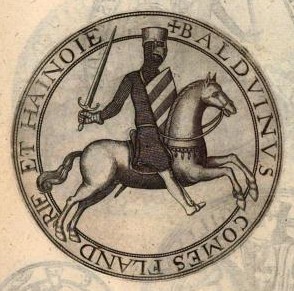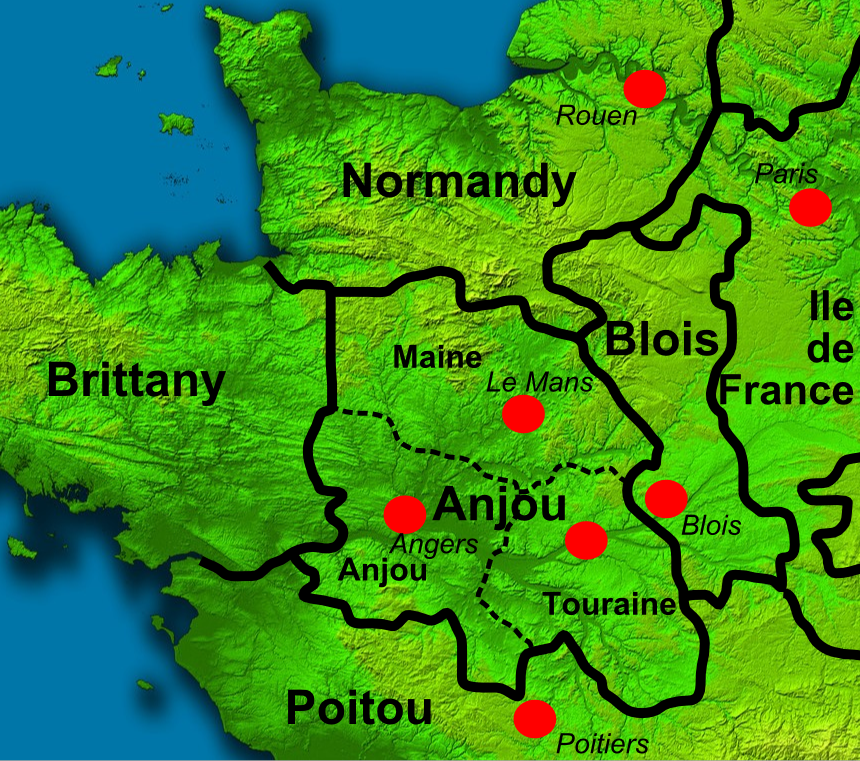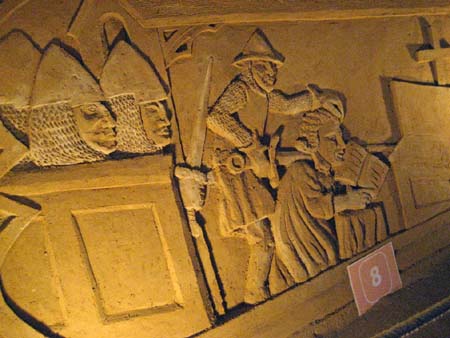|
William De Ipres, 1st Earl Of Kent
William of Ypres (; 1090 – 24 January 116524 January 1164 O.S., 1165 N.S.) was a Flemish nobleman and one of the first mercenary captains of the Middle Ages. Following two unsuccessful bids for the County of Flanders, William became King Stephen of England's chief lieutenant during the civil war of 1139–54 known as the Anarchy. He held Kent, though not the title of earl, until the early years of King Henry II's reign, when he returned to Flanders. Struggle for Flanders William was an illegitimate son of Philip of Loo, who was the son of the Flemish count Robert the Frisian and younger brother of Robert II.Richard Ealesof Ypres, styled count of Flanders (d. 1164/5)"''Oxford Dictionary of National Biography'' William's mother was a wool carder, which further diminished his status; King Louis VI of France pointed out that she never rose from that station. The exact date of his birth is unknown, and although 1090 is the commonly used date of his birth, several o ... [...More Info...] [...Related Items...] OR: [Wikipedia] [Google] [Baidu] |
Lo, Belgium
Lo is a small medieval town in the Belgian province of West Flanders in Belgium and a borough of the municipality Lo-Reninge. Lo is part of the community Lo-Reninge, which obtained the city title in 1985. The Old Town Hall of Lo, built between 1565-1566, and its belfry were inscribed on the UNESCO World Heritage List in 1999 as part of the Belfries of Belgium and France site. Lo is the location of Caesarsboom, an ancient European Yew designated a national monument A national monument is a monument constructed in order to commemorate something of importance to national heritage, such as a country's founding, independence, war, or the life and death of a historical figure. The term may also refer to a sp ... of Belgium.Walking the Walls: Kent Coun ... [...More Info...] [...Related Items...] OR: [Wikipedia] [Google] [Baidu] |
Count Baldwin VII
Baldwin VII (1093 – 17 July 1119) was Count of Flanders from 1111 to 1119. Baldwin was the son of Count Robert II of Flanders and Clementia of Burgundy. He succeeded his father as count when he died on 5 October 1111. Reign Baldwin succeeded his father as count when he died on 5 October 1111. He was under the influence of his powerful mother Clementia of Burgundy. He tried to assert independence from her, but she still remained influential behind the scenes. Baldwin was an impetuous and impulsive young man, extremely hostile towards Henry I of England. The inexperienced new count solicited the advice of his cousin, Charles the Good, who was several years older. It was Baldwin who arranged the marriage of Charles to the heiress of the County of Amiens, Margaret of Clermont, in 1118. Baldwin invaded Normandy in 1118 and raided many towns. In 1105, Baldwin married Hawise of Brittany (also called Havide), daughter of Duke Alan IV of Brittany. The groom was twelve and the bride ... [...More Info...] [...Related Items...] OR: [Wikipedia] [Google] [Baidu] |
Count Of Flanders
The count of Flanders was the ruler or sub-ruler of the county of Flanders, beginning in the 9th century. Later, the title would be held for a time, by the rulers of the Holy Roman Empire and Spain. During the French Revolution, in 1790, the county of Flanders was annexed to France and ceased to exist. In the 19th century, the title was appropriated by Belgium and granted twice to younger sons of Belgian kings. The most recent holder died in 1983. In 862 Baldwin I was appointed as the first Margrave of Flanders by Charles the Bald, King Charles II. It was a military appointment, responsible for repelling the Viking raids from the coast of Francia. The title of margrave (or marquis) evolved into that of count. Arnulf I, Count of Flanders, Arnulf I was the first to name himself as count, by the Grace of God. The title of margrave largely fell out of use by the 12th century. Since then, the rulers of Flanders have only been referred to as counts. The counts of Flanders enlarged t ... [...More Info...] [...Related Items...] OR: [Wikipedia] [Google] [Baidu] |
Aalst, Belgium
Aalst (; , ; Brabantian dialect, Brabantian: ''Oilsjt'') is a City status in Belgium, city and Municipalities in Belgium, municipality in the province of East Flanders in the Flemish Region of Belgium. It is located on the Dender River, about northwest of Brussels. The municipality comprises the city of Aalst itself and the villages of Baardegem, Erembodegem, Gijzegem, Herdersem, Hofstade, Meldert, Moorsel and Nieuwerkerken; it is the tenth largest city by population with 90.068 inhabitants. Aalst is crossed by the Molenbeek-Ter Erpenbeek in Aalst and Hofstade. The current mayor of Aalst is Christoph D'Haese, from the Nieuw-Vlaamse Alliantie, New-Flemish Alliance party. The town has a long-standing folkloric feud with Dendermonde, north along the same river, which dates from the Middle Ages. History The first historical records on Aalst date from the 9th century, when it was described as the ''villa Alost'', a dependency of the Abbey of Lobbes. During the Middle Ages, a town ... [...More Info...] [...Related Items...] OR: [Wikipedia] [Google] [Baidu] |
Thierry Of Alsace
Theoderic (, , ; – 17 January 1168), commonly known as Thierry of Alsace, was the fifteenth count of Flanders from 1128 to 1168. With a record of four campaigns in the Levant and Africa (including participation in the Second Crusade, the failed 1157–1158 siege of the Syrian city Shaizar, and the 1164 invasion of Egypt), he had a rare and distinguished record of commitment to crusading. Countship Theoderic was the youngest son of Duke Theoderic II of Lorraine and Gertrude, daughter of Count Robert I of Flanders. After the murder of his cousin, Charles the Good, in 1127, Theoderic claimed the County of Flanders, but another cousin, William Clito, became count instead with the support of King Louis VI of France. William's politics and attitude towards the autonomy of Flanders made him unpopular, and by the end of the year Bruges, Ghent, Lille, and Saint-Omer recognized Theoderic as a rival count. Theoderic's supporters came from the Imperial faction of Flanders. Louis VI ... [...More Info...] [...Related Items...] OR: [Wikipedia] [Google] [Baidu] |
Stephen Of Blois
Stephen (1092 or 1096 – 25 October 1154), often referred to as Stephen of Blois, was King of England from 22 December 1135 to his death in 1154. He was Count of Boulogne ''jure uxoris'' from 1125 until 1147 and Duke of Normandy from 1135 until 1144. His reign was marked by the Anarchy, a civil war with his cousin and rival, the Empress Matilda, whose son, Henry II, succeeded Stephen as the first of the Angevin kings of England. Stephen was born in the County of Blois in central France as the fourth son of Stephen-Henry, Count of Blois, and Adela, daughter of William the Conqueror. His father died as a crusader while Stephen was still young, and he was brought up by his mother. Placed into the court of his uncle Henry I of England, Stephen rose in prominence and was granted extensive lands. He married Matilda of Boulogne, inheriting additional estates in Kent and Boulogne that made the couple one of the wealthiest in England. Stephen narrowly escaped drowning with Henry I' ... [...More Info...] [...Related Items...] OR: [Wikipedia] [Google] [Baidu] |
Duchy Of Normandy
The Duchy of Normandy grew out of the 911 Treaty of Saint-Clair-sur-Epte between Charles the Simple, King Charles III of West Francia and the Viking leader Rollo. The duchy was named for its inhabitants, the Normans. From 1066 until 1204, as a result of the Norman Conquest of England, the dukes of Normandy were usually also kings of England, the only exceptions being Dukes Robert Curthose (1087–1106), Geoffrey Plantagenet, Count of Anjou, Geoffrey Plantagenet (1144–1150), and Henry II of England, Henry II (1150–1152), who became king of England in 1154. In 1202, Philip II of France declared Normandy forfeit to him and Invasion of Normandy by Philip II of France, seized it by force of arms in 1204. It remained disputed territory until the Treaty of Paris (1259), Treaty of Paris of 1259, when the English sovereign ceded his claim except for the Channel Islands. With the mainland portions of the Duchy absorbed into the Royal domain of France, French Royal Domain, the now much ... [...More Info...] [...Related Items...] OR: [Wikipedia] [Google] [Baidu] |
William Clito
William Clito (25 October 1102 – 28 July 1128) was a member of the House of Normandy who ruled the County of Flanders from 1127 until his death and unsuccessfully claimed the Duchy of Normandy. As the son of Robert Curthose, the eldest son of William the Conqueror, William Clito was seen as a candidate to succeed his uncle King Henry I of England. Henry viewed him as a rival, however, and William allied himself with King Louis VI of France. Louis installed him as the new count of Flanders upon the assassination of Charles the Good, but the Flemings soon revolted and William died in the struggle against another claimant to Flanders, Thierry of Alsace. Youth William was the son of Duke Robert Curthose of Normandy and Sibylla of Conversano. His father was the first son of King William the Conqueror of England. His nickname ''Clito'' was a Medieval Latin term equivalent to the Anglo-Saxon ''" Aetheling"'' and its Latinized form ''"Adelinus"'' (used to refer to his first cou ... [...More Info...] [...Related Items...] OR: [Wikipedia] [Google] [Baidu] |
Ypres
Ypres ( ; ; ; ; ) is a Belgian city and municipality in the province of West Flanders. Though the Dutch name is the official one, the city's French name is most commonly used in English. The municipality comprises the city of Ypres/Ieper and the villages of Boezinge, Brielen, Dikkebus, Elverdinge, Hollebeke, Sint-Jan, Vlamertinge, Voormezele, Zillebeke, and Zuidschote. Together, they are home to about 34,900 inhabitants. During the First World War, Ypres (or "Wipers" as it was commonly known by the British troops) was the centre of the Battles of Ypres between German and Allied forces. History Origins Ypres is an ancient town, known to have been raided by the Romans in the first century BC. It is first mentioned by name in 1066 and is probably named after the river Ieperlee on the banks of which it was founded. During the Middle Ages, Ypres was a prosperous Flemish city with a population of 40,000 in 1200 AD, renowned for its linen trade with England, which w ... [...More Info...] [...Related Items...] OR: [Wikipedia] [Google] [Baidu] |
Henry I Of England
Henry I ( – 1 December 1135), also known as Henry Beauclerc, was King of England from 1100 to his death in 1135. He was the fourth son of William the Conqueror and was educated in Latin and the liberal arts. On William's death in 1087, Henry's elder brothers Robert Curthose and William Rufus inherited Duchy of Normandy, Normandy and England, respectively; Henry was left landless. He purchased the County of Cotentin in western Normandy from Robert, but his brothers deposed him in 1091. He gradually rebuilt his power base in the Cotentin and allied himself with William Rufus against Robert. Present in England with his brother William when William died in a hunting accident, Henry seized the English throne, promising at his coronation to correct many of William's less popular policies. He married Matilda of Scotland and they had two surviving children, Empress Matilda and William Adelin; he also had many illegitimate children by his numerous mistresses. Robert, who invaded from ... [...More Info...] [...Related Items...] OR: [Wikipedia] [Google] [Baidu] |
Galbert Of Bruges
Galbert of Bruges (Galbertus notarius Brugensis in Latin) was a Flemish cleric and chronicler. A resident of Bruges and a functionary in the administration of the count of Flanders, he is known for his day-by-day Latin account ''De multro, traditione et occisione gloriosi Karoli comitis Flandriarum'' of the events surrounding the murder of Count Charles the Good in 1127 and the ensuing civil war in Flanders up to the accession of Thierry of Alsace as count in the summer of 1128. References *Alan V. Murray. 1994. ‘Voices of Flanders: Orality and Constructed Orality in the Chronicle of Galbert of Bruges’, ''Handelingen der Maatschappij voor Geschiedenis en Oudheidkunde te Gent'' n.s. 48, pp. 103–119 *Jeff Rider (translator). 2013. ''The Murder, Betrayal, and Slaughter of the Glorious Charles, Count of Flanders'' by Galbert of Bruges. New Haven and London: Yale University Press. . *Jeff Rider (editor). 1994. ''De multro, traditione, et occisione gloriosi Karoli comitis Fland ... [...More Info...] [...Related Items...] OR: [Wikipedia] [Google] [Baidu] |
Adela Of Flanders
Adela of Flanders (also Ala and Alana in southern Italian sources) (c. 1064 – April 1115), was Queen consort of Denmark by marriage to King Canute IV and duchess of Apulia by marriage to Duke Roger Borsa, and then regent of Apulia from 1111 to 1115 as mother and guardian of Duke William II. Life Adela was born the daughter of Robert I, Count of Flanders, and Gertrude of Saxony. In 1080, she married King Canute IV of Denmark. The marriage was arranged as a part of an alliance between Flanders and Denmark against William the Conqueror. During this marriage, she had three children: a son, later Count Charles the Good (born in 1084), and twin daughters, Cecilia and Ingegerd (born ca. 1085/86). When Canute was assassinated in 1086, she fled with her son to Flanders, leaving her daughters behind in Denmark. She stayed in the court of her father and brother Robert II until 1092, when she left for Italy to marry Roger Borsa Roger Borsa (1060/1061 – 22 February 1111) was the ... [...More Info...] [...Related Items...] OR: [Wikipedia] [Google] [Baidu] |





